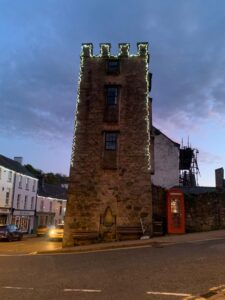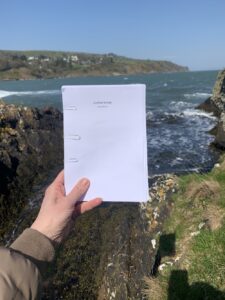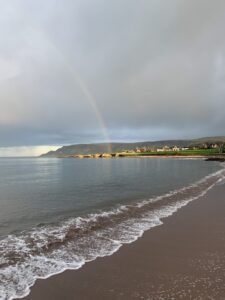Emma Warren, the first Caught by the River writer to take up residence in the Curfew Tower, shares the fruits of her time in Cushendall.

I arrived in Cushendall on the 150 bus from Ballymena on the first day of April. I brought a suitcase full of books, a sizable bag of nerves and a little bit of publication burnout, as well as the excitement of going somewhere I knew about through second hand lore. I also brought some assumptions: that I was going to a colonial edifice, built with extractive landlord energy to control and oppress the people who live here. The Curfew Tower does contain these histories, but it contains many other stories too. It is as rich and complex as the Glens themselves, or County Antrim, or indeed the whole of Northern Ireland.
My intention was to find and interview people connected with youth clubs, to volunteer at youth club sessions, and to try and understand how youth work affected music and culture in this part of the world. I realised quickly that I’d also need a way to understand what I was doing, and to try and understand who this location made me. Any new place alters the way you appear on the outside and feel on the inside. Staying in this four-storey tower on the crossroads in the centre of the village (pop: 1,280) significantly magnified this process.
The cost of staying in the tower, famously owned by Bill Drummond, is a piece of art made by each temporary resident. This creative taxation was evident in pieces stacked up against the walls — and in the case of the joker who painted luminescent ghouls on the walls of both bedrooms, jump-scare visible only once you turned the lights off.
Visual art is not my strong point and so I was wondering what I’d leave behind. I mentioned to a friend a half-idea about writing a poem a day. They responded positively and passed on a gem which had been passed on to them: the idea that poetry is functional. The phrase acted as permission and encouragement and I got to work, turning one aspect of each day into a word-picture, scribbling down drafts by the beach on a soft grassy rock between Cushendall and Red Bay, and working on them over subsequent days in Café Cova.
By the end of my twenty-one days in the tower I had twenty finished pieces of what I’m now calling ‘poetic non-fiction’. Instead of writing another one on my last day, I printed them out so that I could blu-tack copies to the wall of the tower before new friends and acquaintances arrived for an end-of-stay celebration. I also made thirty A5 copies of the whole thing, printed in the order I wrote and edited them. I allocated it a title, Curfew Songs, and a catalogue number (Sweet Machine 003), and bound them with paper clips because the local Spar didn’t have the tiny bulldog clips I was after. I handed them out to the people who appeared in or under the lines and left a copy in the Curfew Tower.

This was a functional process in which I dispensed of any worries about quality. It’s my response to Cushendall as a layered, storied and lyrical place, at least as I saw it from my small green desk by the window, looking up Bridge Street towards McMullan’s Central Bar and the Lurig Inn. Of course, it’s also about the Curfew Tower itself, and I don’t have enough words to begin describing what a rare, complex, confusing and powerful place it is. In short, I’ll probably be wondering about it for the rest of my life.
On a more practical level, these writings are about — and for — the people I met: my fellow dancers at the Tuesday lunchtime dance class at the community-built Glenariff Community and Recreation Centre, and for Zippy, custodian of the key and of key intel. They’re functional in this way too, as gifts; an offering to the new friends who took me places by foot or in their cars, and who entertained conversation with me at shop counters, on street corners and in their homes. It’s collective material, including some generated by the three artists I invited to come and visit: writer Wendy Erskine, film-maker Clare Tavernor and visual artist Annie Nicholson. My mum, Meg, also appears towards the start of the Curfew Songs because she unilaterally decided that the duration of my stay was the perfect time to take a trip to Belfast, and from there to hop on the 150 bus from Ballymena, on the off-chance that I was around for a cup of tea.
Meg wasn’t the only south-east London connection in Cushendall. I lost count of the number of people I met with Lewisham links, including someone who’d lived down Lee High Road and a man who helped build the circular staircase in the centre of the Laban Centre by Deptford Creek, where I took contemporary dance class in the late 2010s. My home location was identified by my accent on at least three occasions. All of this gave me a new appreciation of diasporic connectedness and the interplay between my part of south-east London and this part of Northern Ireland. It gave me the identity glow that comes with an interaction that places you within something, and which makes you make sense, even if you’re a stranger. It helped me understand new aspects of what it means to have been brought up Catholic by the daughter of an Irishwoman, just inside the M25. The section I’m sharing with Caught by the River explores these unexpected South London undercurrents (and make passing reference to the boy racers who screech and rev through the village on weekends, blaring out hardcore).
Three weeks in the Curfew Tower provided the luxury of a pause. That it did so in such a beautiful place, where I was able to meet so many warm and lovely people, more than made up for the luminescent ghouls.

South London Symphony
I. Electric Avenue, Cushendall
In 1980s Brixton Eddy Grant
celebrated the histories:
England’s first street
to step from gas into electricity.
Cushendall lit more than a street
– a whole village –
the first in Ireland,
setting light to the present.
Futuristic histories
have a long tail
and respond to ignition,
echoing around the glens.
II. Bernadette’s House Party
I take the curry puffs
to the woman who made them
transporting a compliment,
and start a story
about curry puffs and patties
in Covent Garden.
Her glensman husband interjects:
Puffs and patties are quite different.
He’s sensing a conflation,
and stepping in.
I know, I say
I’m from south London,
shorthand that generates a shift
and we walk it together:
triplets in time-travel,
down from the Harp Club in New Cross
along Deptford High Street
renegade congregation at The Bird’s Nest
past the chalk board at Honey’s,
which lists patties, and Guinness Punch.
III. Kent Borders
London has diaspora too
and we find each other in nuances
scanning for references
and sharing code, just in case
like the man in the Lurig Inn
who approaches me and Clare,
who is from Belfast and Newcastle
and Cornwall and London.
His question: ‘are you local?’
is answered through my accent
which he locates – almost precisely –
and then pinpoints, perfectly pitched.
I confirm through the words south
and Londoner and Lewisham and Bromley.
There’s a pause, and he changes stance
to speak of correction, specificity.
South East London, he says
and asks if I know a family, Lee:
the father wild fun
a bare-knuckle fighter.
I knew a Deborah Lee
at St John Rigby school
dark haired, wild quiet,
magnetised towards the edges.
IV. A Prayer for Jah Shaka
News from home reaches me
on Whatsapp: ‘Shaka passed’
and a reverse smiley face.
Late ‘90s we were neighbours
brickwork conducting day
and night, a dread broadcast.
After a fire, his front lawn
littered with curled 7s
a rescue mission which
landed him in Lewisham hospital
smoke inhalation.
He recovered, hallelujah,
legendary selector
come again.
Generations received
his one deck dispensations
sonic information delivered
back turned to the dancers
better to hear the music
and the message
and the system
beating down Babylon, for life.
The stencilled boiler suits may fade
but memory never. This South London warrior
charged up a long echo,
b-line blowing eternal and
in the distance, I hear Chicago
– London through the looking glass –
and a life-giving chorus, acapella:
I will never die/ cuz I be indestructible consciousness.
Shaka is dead, the week after Easter.
South London mourns
whilst knowing the truth:
Jah Shaka will live forever and ever
Amen.
*The Chicago acapella is used by Angel Bat Dawid and her band Tha Brothahood when they perform.